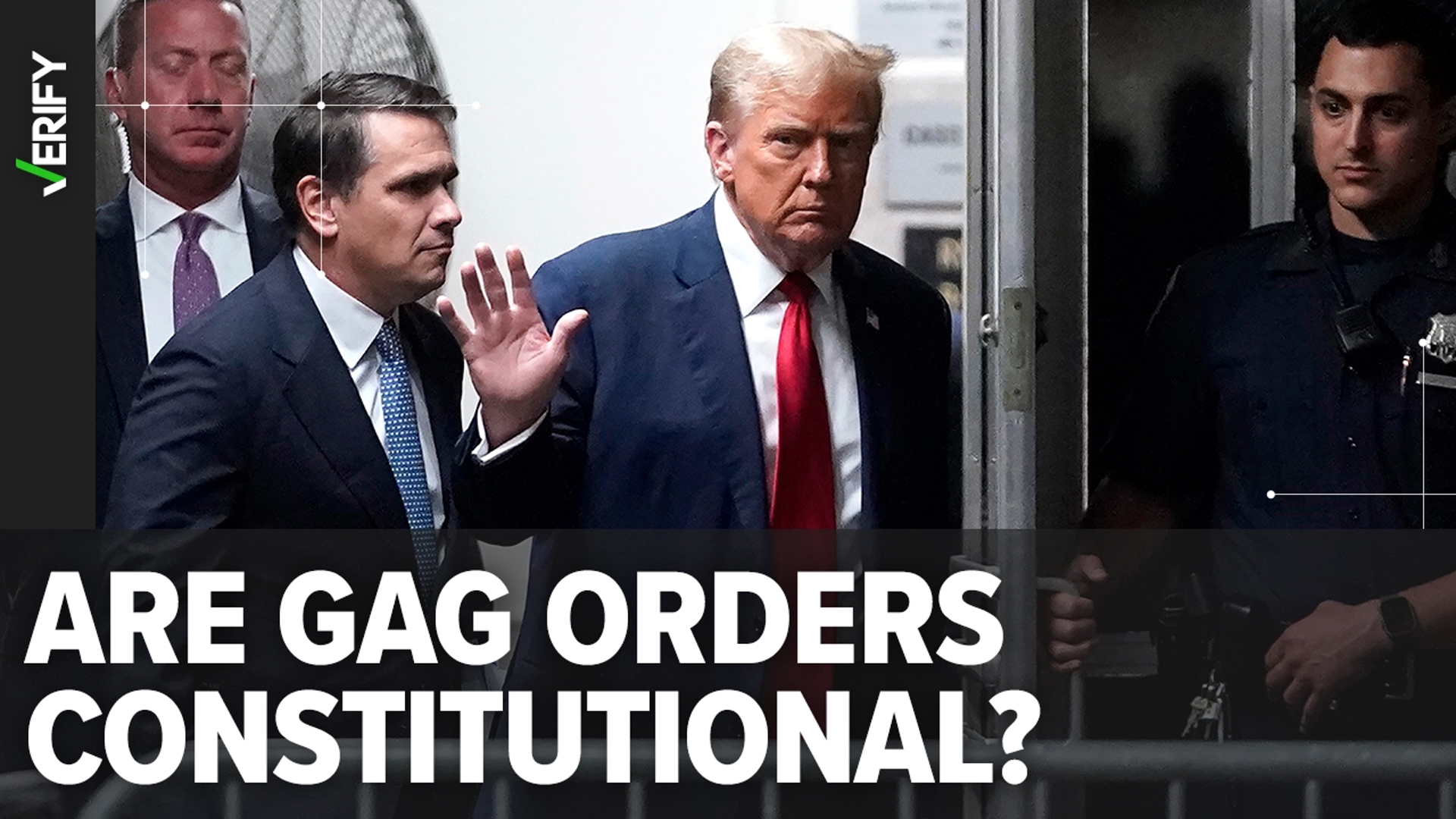Former President Trump has been fined $9,000 by a judge and declared to be in contempt of court in the New York criminal trial where he’s accused of covering up hush money payments to a porn star.
The judge said Trump violated an order not to attack witnesses and other key participants in the trial when he repeatedly posted about them on Truth Social.
Such court-imposed orders are often called gag orders, and since they restrict what a person is allowed to say publicly, VERIFY reader Richard wondered how they can be legal given the First Amendment’s free speech protections.
THE QUESTION
Are gag orders constitutional?
THE SOURCES
- U.S. Constitution
- U.S. Supreme Court
- Ken Paulson, Director of the Free Speech Center at Middle Tennessee State University
THE ANSWER
The Supreme Court has found some gag orders are constitutional and others are not. The First Amendment right to free speech must be weighed with the Sixth Amendment right to a fair trial, on a case-by-case basis.
WHAT WE FOUND
Gag orders aren’t common, but in certain cases they’re used to prevent potential witness tampering or attempting to unduly influence jurors through public media campaigns. Courts can assess whether gag orders are constitutional on a case-by-case basis.
The First Amendment to the U.S. Constitution guarantees the right to free speech, but the Sixth Amendment guarantees the right to a fair and speedy trial, and sometimes these two things can be at odds.
“This is a classic confrontation of constitutional rights,” said Ken Paulson, director of the Free Speech Center at Middle Tennessee State University.
The Supreme Court has ruled both that excessive public speech about a trial can result in it becoming unfair, making gag orders necessary, and that judges’ attempts to quash such speech can go too far and infringe on First Amendment rights.
There are several key cases that shape how the Supreme Court currently views the constitutionality of gag orders.
For example, in the 1950s a murder trial in Cleveland became a media circus. Personal information about witnesses and jurors was widely publicized, the judge told a reporter he thought the defendant was guilty, and jurors were allowed to make phone calls during deliberations.
The defendant was convicted, but in 1966 the U.S. Supreme Court overturned the conviction and found that the publicity resulted in an unfair trial.
“The Supreme Court said then that it was within the rights of a judge – in order to protect the Sixth Amendment rights of a defendant – to tell those who are participating in the trial that they may not speak publicly, including to the press, about the case,” said Paulson.
After that ruling, some judges began to clamp down on what could be publicly said during their trials, both by participants and the press. But that authority only goes so far.
In 1976, the Supreme Court struck down a gag order issued by a judge in Nebraska, in which he ordered local media not to report details of a murder trial. The justices ruled it’s almost always unconstitutional for a judge to tell the press what they can and can’t publish, but they didn’t restrict gag orders on trial participants.
“[The Supreme Court] basically said: you can tell the people that the news media get their information from not to talk, but you can't tell the news media not to talk,” said Paulson. “Important principle. Survives to this day.”
These two rulings helped establish the current parameters judges use when issuing gag orders: balancing free speech with ensuring a fair trial.
"With gag orders, it's actually a compromise. What it does is say: ‘You're a member of this trial, you are either a defendant, you're a lawyer, you're an official. And… in the interest of protecting the Sixth Amendment rights of this defendant, we're going to tell you to shut up for a while,” said Paulson. “On the other hand, what can I tell the press? ‘You can write about anything you want to. You can write freely about the events in the courtroom, you can analyze the case, you can report whatever you'd like.’ So on one hand, the Sixth Amendment is protected, and on the other the First Amendment is protected. It's actually a pretty good balance.”
In Trump’s New York case, the judge has argued a gag order is necessary to prevent Trump from potentially intimidating witnesses and jurors.
Judges, generally speaking, have discretion to decide how to weigh the First and Sixth Amendment factors in these cases, but gag orders can be appealed to higher courts.
Trump appealed the New York gag order, but the appellate court rejected his claims. His lawyers have not said whether they will try to appeal again to a higher court.
“It's rare for any decision along those lines to be overturned by an appellate court, and it would be extraordinarily rare [for] someone to be able to get the Supreme Court to hear it,” said Paulson. “So bottom line is: establishing a reasonable limit on the participants is almost always going to be upheld.”

